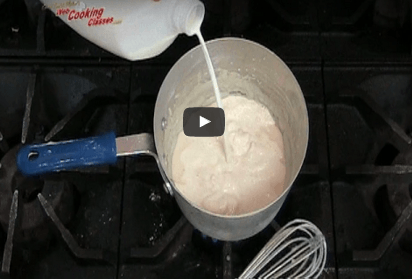I’m asked a LOT of cooking questions, many of them about failed cheese sauce. Every day I’m reminded of the confusion that abounds about cooking when I open my email, chat with my WebCookingClasses members, go to my Facebook page, or contribute to a forum. Many people are baffled about WHY things happen the way they do in their kitchens.
There’s never a stupid question and I never blame the questioner for asking. Most people are not taught HOW food cooks, they’re just told to follow a set of written instructions. I have a compassion for people that send me their cooking challenges like they were trying to assemble a piece of Scandinavian furniture from the box. I know how frustrating trying to follow someone else’s written directions can be, that’s why I often say “Recipes Don’t Work“!
One of the queries I get most often is about making white sauces. Home cooks often want to know how to make a cheese sauce for Macaroni and Cheese or an Alfredo Sauce for pasta. Their question often begins with, “the recipe said to ……”
Before anyone else spends their valuable time looking for a cheese sauce recipe or an Alfredo sauce recipe and trying to follow confusing instructions, I’d like to make it simple for you by demonstrating what professional chefs know. If you can make a Bechamel sauce, you can make ANY and EVERY homemade sauce like the pros.
Bechamel sauce is one of the 5 Mother Sauces I teach in culinary college, but it’s not difficult nor complicated, and anyone can master the few simple steps. It’s most simply defined as milk thickened with roux.
Basic White Sauce calls for equal amounts of butter and flour to create a roux. Then, milk is added to the hot roux in small increments to observe the thickening power of the roux. This is a No-Recipe method to making all great sauces that start with roux. I don’t measure the roux, I don’t measure the milk, but I DO watch closely for the changes in my sauce.
The science behind thickening liquids with a flour and fat mixture is called Gelatinization of Starches. At 150F (65C), starches absorb liquids and swell. This process turns milk or any other liquid into a thickened sauce that will stick to food. It’s the best way to make a high quality sauce quickly.
However, it’s the PROCESS that’s most important in making a basic white sauce. You cannot combine flour and liquid because starch molecules will gelatinize on the outside of a group of them stuck together. That’s how Grandma got her lumpy gravy.
Starch molecules must be separated with the introduction of fat. That’s why the ability to make a good roux is important. The roux is the thickening agent for the milk, and a weak thickener will mean a weak sauce.
Adding milk in small increments not only allows for the starches to absorb the liquid, but it doesn’t overwhelm the starch nor drop the temperature of the roux so quickly that the whole thing turns to mush. The most important part of slowly adding milk is your ability to WATCH the changes going on in the pan. When you rely on a recipe, you spend time looking at the clock because they teach you to cook by TIME.
Cook with your EYES instead, armed with confidence in the basic methods behind cooking and you’ll be able to make dozens of improvised sauces because you know the secrets behind making a great bechamel sauce like I teach in culinary school.

